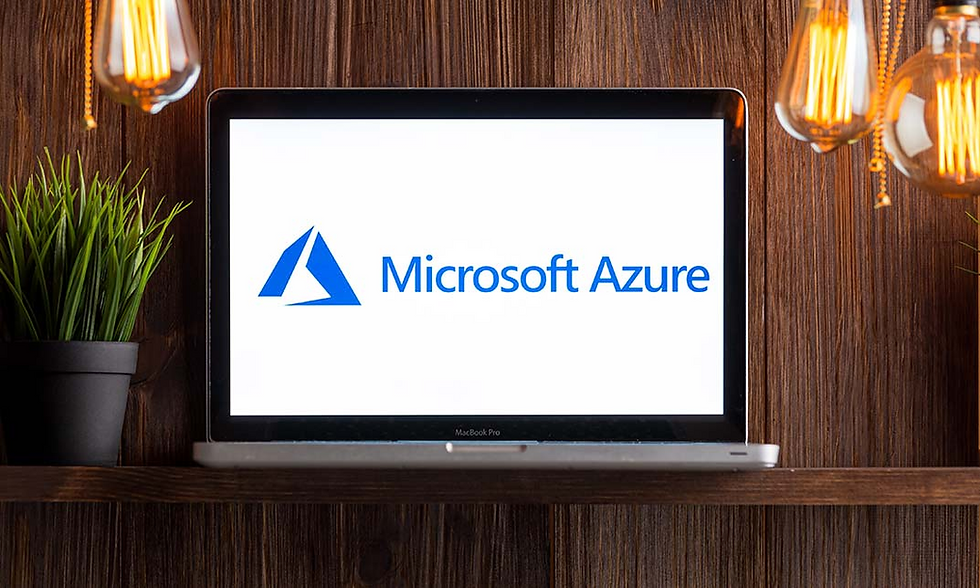5 reasons why SMBs should be using Microsoft Azure
- emilyangold
- Apr 3, 2023
- 4 min read
Updated: Jun 23, 2023
As more businesses look towards the cloud as the future of business infrastructure, many companies are choosing Microsoft Azure as the perfect cloud solution for their business needs — with Microsoft Azure being the second biggest cloud infrastructure services vendor in the world.
Especially for SMBs, Azure is the best option available for migrating to the cloud. The options available with Azure are the most suitable for the needs of an SMB in the modern business environment.
We believe that Azure is the best choice for any SMB looking to make use of cloud infrastructure. That’s why in this article, we’re going to go over what Azure actually is, and why you should be using it today.
What is Azure?
Microsoft Azure is a public cloud computing platform that provides cloud solutions for companies and organisations around the world. Originally named Windows Azure, it has been providing cloud solutions since 2008 and is incredibly popular worldwide.
Azure primarily provides three kinds of services — Infrastructure as a Service (IaaS), Platform as a Service (PaaS), and Software as a Service (SaaS) — and has many integrations within the wider Microsoft ecosystem, working well with Microsoft 365.
5 Reasons Why SMBs Should be Using Azure
Pricing
As an SMB, making a capital investment (CAPEX) is a much larger investment, as you typically won’t expect to see a return on your investment for 3 to 5 years.
However, utilising Azure for your business’s cloud infrastructure allows you to turn that investment into operational expenditure (OPEX). This means that you can start small and scale appropriately as your business grows, without having to make a large investment that you’re stuck with for the foreseeable future.
Azure also lets you turn off anything you’re not using, allowing you to manage costs much more effectively. With a physical infrastructure, you’d still have that expenditure and the costs associated with it.
All around, Azure is the best way to help SMBs looking towards the cloud effectively budget and use their money most effectively and appropriately for the needs of their business.
Enable Flexibility
As stated previously, Microsoft operates three primary services — IaaS, PaaS, and SaaS:
Infrastructure as a Service: With IaaS, Microsoft provides the basic infrastructure and leaves the rest to you, to utilise as you require. This is the most basic service offered.
Platform as a Service: In addition to everything offered with IaaS, PaaS offers important platform tools such as operating systems and other development, analytics, and management tools.
Software as a Service: SaaS also provides all of the above, as well as providing hosted applications for your business, for example Microsoft 365.
With access to all three of these types of services, your business has flexibility and can easily use the service that provides what you need without paying extra costs for things that you don’t.
If you wanted to be flexible with an on-prem system, you’d have to have the infrastructure to do all three of the above — which means more CAPEX and more infrastructural upkeep costs in the long term.
Enterprise Grade Security
Security is important for any business, and utilising Azure as your cloud infrastructure solution over an on-prem system is the best way to secure your information from any malintent.
By utilising Azure for your cloud infrastructure, all of your data is stored within their servers. This means that it’s safe and that it’s not going to be open to a breach from any attacker looking to destabilise, harm, or even cripple your business.
This means that by using Azure, you can rest easy knowing that your data is in good hands and that you’re not leaving your system vulnerable to attacks.
Scale with Your Business
Scaling a physical infrastructure is difficult, costly, and requires lots of planning and action to do properly, without any issues. It can be a real pain, and scaling physical infrastructure is usually only limited to scaling up.
Azure allows you to freely scale your business. This means that you can easily increase the number of resources in your system, or decrease them, with a few clicks. No added expenditure other than the service cost, and you don’t have to worry about buying new hardware.
Enable Digital Transformation
Digital transformation is pushing forward the business industry around the world, and making companies everywhere more innovative and agile.
The benefits of digital transformation — innovation, agility, efficiency, and so many more — mean that there’s never been a better time for moving your business to the digital space.
Azure’s online, cloud-based solutions enable this and allow your business to reach new heights in today’s world.
The possibilities available with the digital world and the cloud are enabled fully by Azure. From machine learning and AI to smart analytics and data strategy, Azure is part of why industry leaders worldwide are able to keep at the forefront of pushing the envelope.
From soft drink giants PepsiCo to fuel company Shell, Microsoft Azure has fully allowed large and small companies around the world to utilise new technologies to innovate and take their businesses to new heights.
How we can help
The cloud-based future is here. Companies that utilise the cloud to their advantage are the ones that are staying ahead of the curve — innovating and allowing their business to stay flexible and efficient, while also saving costs all around.
For SMBs, the benefits of cloud solutions allow you to save costs and avoid CAPEX whilst also giving you the tools you need to grow your business. Instead of having to worry about buying hardware to ensure on-prem flexibility, Azure lets you scale freely with a few clicks — as well as offering multiple services to ensure maximum coverage of your needs.
Are you looking to make the move to the cloud with Azure? Our expert team is here to help!





Comments